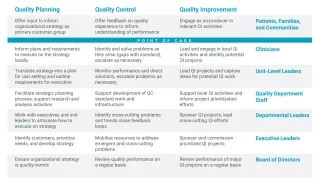Why It Matters
Peter Senge, Senior Lecturer at the Sloan School of Management at MIT, introduced the term “learning organization” to identify an institution “where people continually expand their capacity to create the results they truly desire, where new and expansive patterns of thinking are nurtured, where collective aspiration is set free, and where people are continually learning how to learn together.” Building on Senge’s definition of learning organizations, W. Edwards Deming’s view of a leader’s role in promoting quality, and Joseph Juran’s notion of a quality-centric organization, the Institute for Healthcare Improvement (IHI) proposes a holistic approach to integrate learning into health systems: whole system quality. The following excerpt on learning organization culture is from IHI’s Whole System Quality: A Unified Approach to Building Responsive, Resilient Health Care Systems white paper.
Fostering a culture of improvement and continuous learning requires whole system quality leadership principles — the social norms and patterns of behavior that form the foundation for implementing the Quality Planning, Quality Improvement, and Quality Control activities (depicted below in Figure 1) — that enable problem identification, experimentation, and codification of solutions that work best.

Figure 1. Whole System Quality Approach: Quality Planning, Quality Control, and Quality Improvement Activities by Stakeholder Group
These principles apply to leadership at all levels of the organization (e.g., unit, department, executive, board). Engaging in these leadership principles over time will ultimately advance organizations toward the aspiration of psychological safety, a culture of trust, constancy of purpose, equity, and innovation — all hallmarks of success.
- Psychological safety: Anyone in the organization, including patients and families, can comfortably voice concerns, challenges, and ideas for change
- Culture of trust: An environment of non-negotiable respect, ensuring that people feel their opinions are valued, and any negative or abusive behavior is swiftly addressed
- Constancy of purpose: Apply organizational mission, vision, and values to every decision and always in service of quality (to meet the evolving needs of patients, populations, and communities) continuously, reliably, and sustainably
- Commitment to equity: Continually foster critical dialogue on identity and experience, take corrective action to address institutional and structural inequities, and create conditions in which all people, staff members and customers alike, have every opportunity to attain their highest potential
- Discipline of innovation: “The effort to create purposeful, focused change in an organization’s social or economic potential.” This is achieved through a systematic examination, within and beyond the organization, to identify the areas of change that offer opportunities for creating new sources of value. Areas of change include adopting new ideas for application as well as abandoning practices that no longer serve the organizational vision.
Four Elements of a Learning Organization
Creating the necessary infrastructure for whole system quality requires a shared commitment to continuous learning. To that end, an organization must cultivate a community of learners, each curious to explore new ideas and practices. Such a mindset, established through shared behaviors and social norms, would relieve the workforce of “unproductive performance pressure, freeing [them] to offer ideas and to experiment in order to develop effective solutions.”
Peter Senge, a systems scientist and leading scholar in organizational development, coined the term “learning organization” to describe a group of people working collectively to create a future they desire through continuously seeking to learn and understand their current circumstances and their full potential. An organization committed to profound learning is one in which each individual contributes to the shared vision, appreciates the interdependencies of the system, participates in dialogue with candor and curiosity, and practices self-reflection and metacognition. These behaviors serve as a foundation for building a community where knowledge and understanding is highly prized, openly shared, and consistently applied to create the envisioned future. The culture of a learning organization coupled with a management structure that enables exchange of insights, priorities, and plans unlock the capacity for any organization to realize their vision for quality.
To learn more about how whole system quality links to customer needs, organizational vision, and quality strategy, download the free IHI White Paper, Whole System Quality: A Unified Approach to Building Responsive, Resilient Health Care Systems.
Photo by Zhipeng Ya | Unsplash
You may also be interested in:
